A stateful managed instance group (stateful MIG) preserves the unique state of each virtual machine (VM) instance—including VM name, attached persistent disks, IP addresses, and/or metadata—on machine restart, recreation, auto-healing, or update.
This page describes how stateful MIGs work. See Configuring stateful MIGs to learn how to set up a stateful MIG.
Overview of how stateful MIGs work
A MIG is considered stateful if you have created a stateful configuration.
You create a stateful configuration by setting a non-empty stateful policy and/or one or more non-empty per-instance configurations:
- A stateful policy defines items that you want to preserve for all instances in your MIG.
- A per-instance configuration defines items to preserve for a specific VM instance.
The configuration is effective after you or the MIG applies it:
- A MIG automatically applies your stateful policy configuration to new and existing instances.
- When creating or updating per-instance configurations, you can choose whether to apply the new configuration manually or have it applied automatically.
After the stateful configuration (stateful policy and/or per-instance configurations) is applied, you can verify it by inspecting the preserved state of each managed instance.
Subsequent changes to your MIG's stateful configuration or size (for example, decreasing the MIG's size, or deleting or abandoning instances from the MIG) can affect the preserved states of the instances.
How stateful configuration is applied to managed instances
Your stateful configuration is effective after you or the MIG applies it. Applying stateful configuration to a MIG's instances depends on the configuration:
- Stateful policy: The MIG automatically applies your stateful policy configuration to new and existing instances.
- Per-instance configurations: When creating or updating per-instance configurations, you can choose whether to apply the new configuration manually or have it applied automatically.

How stateful policy updates are applied to instances
When you create or update a stateful policy, for example add or remove a stateful disk, the MIG applies your stateful policy configuration to all managed instances in the group automatically and asynchronously. A MIG also automatically applies your stateful policy configuration to new instances during their creation, for example, when a MIG's size is increased or when you create instances in the MIG manually.
After the configuration is applied, you can see the effect of the update in each managed instance's preserved state from policy.
Updates to a stateful policy do not disrupt running VMs.
When you update a stateful policy to add a stateful disk, the MIG updates each
VM resource,
changing the value of the disk's autoDelete flag
(instances.disks[].autoDelete):
- The MIG sets
autoDeletetoFALSEfor disks that you configure as stateful. This prevents deletion of that disk on instance recreation by autohealing, updating, or manual recreation. - The MIG sets
autoDeleteto match your instance template configuration (instanceTemplates.disks[].autoDelete) for all disks that are to be stateless.
Changing the value of the autoDelete flag does not disrupt a running VM.
How per-instance configuration updates are applied to instances
When you create or update a per-instance configuration, you can choose whether to apply the new configuration manually or automatically. For more information, see Applying stateful configuration from per-instance configurations.
The following table shows the disruption levels that are required to apply different per-instance configuration updates to a VM:
| Per-instance configuration update | Disruption to VM required for applying |
|---|---|
| Configure a disk, defined by the instance template, to be stateful (added to the per-instance configuration) | REFRESH |
| Configure a disk, defined by the instance template, to be stateless (removed from the per-instance configuration) | REFRESH |
| Add a disk, not defined by the instance template, and attach it to the VM | REFRESH |
| Remove a disk, not defined by the instance template, and detach it from the VM | REFRESH |
| Add a metadata key-value pair | REFRESH |
| Remove a metadata key-value pair | REFRESH |
| Add an external boot disk, not created from the instance template, and attach it to the VM | REPLACE |
| Remove an external boot disk, not created from the instance template, detach it from the VM, and create a boot disk from the instance template instead | REPLACE |
| Set an internal IP address | REPLACE |
| Remove an internal IP address | REPLACE |
When applying an updated per-instance configuration to the corresponding VM, the MIG performs the following actions depending on which stateful items are updated:
- Adds (or removes) disks, IP addresses, or metadata to the preserved state from configuration in the corresponding managed instance.
- Attaches (or detaches) disks that are not defined by the instance template to the VM.
- Sets (or removes) metadata key-value pairs that are specific for the VM.
- Assigns (or removes) specified IP addresses to the VM instance.
After a per-instance configuration is applied to a corresponding managed VM, you can see the effect of the update in the instance's preserved state from configuration.
Preserved state of a managed instance
When it is applied, the MIG translates your instance template and stateful configuration into a "preserved state" for each managed instance.
You can view the preserved state by inspecting a managed instance.
The MIG maintains these preserved states automatically, and the MIG automatically and asynchronously applies this state to each corresponding actual VM instance in the MIG.
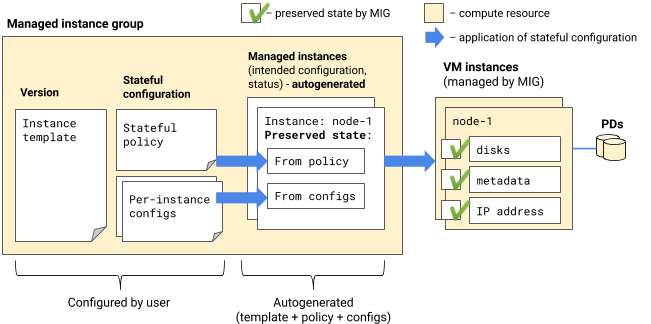
The preserved state describes which individual items (persistent disks, IP addresses, metadata) are stateful for a given instance:
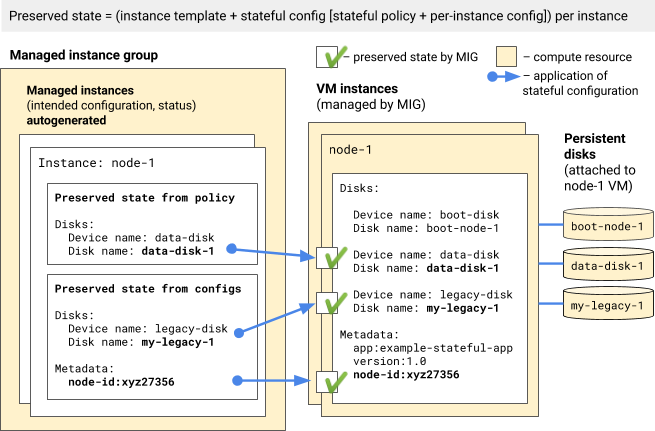
The preserved state generated based on a stateful policy is stored separately from the preserved state generated based on a per-instance configuration. The MIG combines both of them when recreating a VM, with the preserved state from a per-instance configuration taking priority.
Preserved state according to stateful policy
A stateful policy specifies items, present in all instances and defined in the MIG's instance template, to preserve individually for each VM instance in a MIG.
When applied, the MIG translates the stateful policy into
instance-specific preserved states
(managedInstances[].preservedStateFromPolicy). The MIG maintains
these preserved states automatically.
The following example shows a MIG with two VM instances that use a stateful disk defined in a stateful policy that applies to every instance. There are no per-instance configurations in this example.
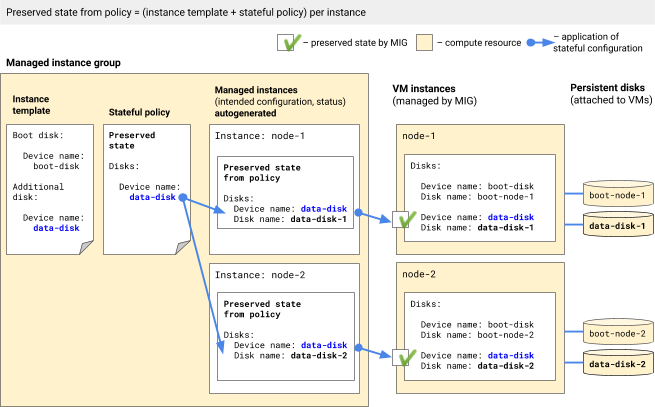
The preceding figure shows a MIG with two instances:
- The instance template defines a boot disk with device name,
boot-disk, and a disk with device name,data-disk, for all instances in the MIG. - The stateful policy declares
data-diskas stateful. The boot disk remains stateless. Note that the disk with device name,data-disk, must be and is defined by the instance template. - After the configuration is applied, the MIG translates the stateful policy into
instance-specific preserved states for each managed instance. The preserved
states instruct the MIG to preserve the disk
data-disk-1for VM instancenode-1and the diskdata-disk-2for the instancenode-2, because both of these disks have device namedata-diskconfigured in the stateful policy. - This example has no per-instance configurations.
Preserved state according to per-instance configuration
A per-instance configuration specifies items that must be preserved for a particular VM. These items don't have to be defined in the MIG's instance template.
When applied, the MIG translates each per-instance configuration into a preserved
state (preservedStateFromConfig) for the corresponding instance.
The following example shows a MIG with two VM instances for which stateful metadata and disks are defined in per-instance configurations (PICs) for every instance. There is no stateful policy in this example.
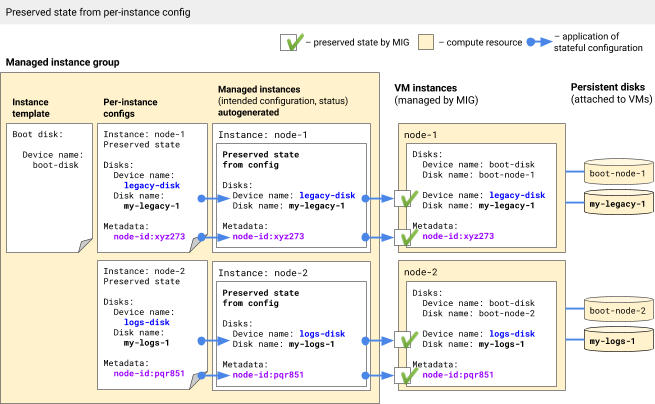
In the preceding figure:
- The instance template defines a boot disk with device name
boot-diskfor all instances in the MIG. The boot disk is stateless for all VMs in the MIG. - Per-instance configurations define the states to preserve for two instances in
the MIG:
node-1andnode-2.- For the
node-1instance, the per-instance configuration defines a diskmy-legacy-1with device namelegacy-diskand metadatanode-id:xyz273. - For the
node-2instance, the per-instance configuration defines a diskmy-logs-1with device namelogs-diskand metadatanode-id:pqr851.
- For the
- After the configuration is applied, the MIG automatically translates the
per-instance configurations into preserved states for each managed instance. The
preserved states instruct the MIG to attach and preserve the following:
- Persistent disk
my-legacy-1and metadatanode-id:xyz273for VMnode-1 - Persistent disk
my-logs-1and metadatanode-id:pqr851for VMnode-2
- Persistent disk
- This example has no stateful policy.
Note that the disks and metadata in the preserved state from per-instance configurations are not defined by the instance template in this example; instead, they are defined by the per-instance configurations only. This is because the configuration that you specify in a per-instance configuration is specific for a particular VM, which means it does not have to be present in the instance template.
Per-instance configurations have priority over stateful policy and instance template
You can configure both a stateful policy and one or more per-instance configurations in one MIG. For example, in a stateful policy, you can define stateful disks that are present in all instances, and in per-instance configurations, you can define instance-specific metadata.
A managed instance's per-instance configuration takes priority over conflicting configuration in the instance template or in a stateful policy.
If you apply a per-instance configuration to add a disk or a network interface
that is already defined in a stateful policy, the MIG stores the stateful
configuration for that disk or network interface in the managed instance's
preserved state from per-instance configuration (preservedStateFromConfig) and
removes the conflicting entries from its
preserved state from policy
(preservedStateFromPolicy). The MIG must
refresh
the VM if the new preserved state is different from the previous one. The
refresh could result in metadata change, external IP address change, or a disk
swap to detach the disk from the last preserved state configuration and attach
the disk specified in the new preserved state configuration.
In the following example, the per-instance configuration for VM instance node-1
redefines:
- The preserved state for the disk with device name
logs-disk, originally defined in the stateful policy - The value for metadata key
logmonth, originally defined in the instance template.
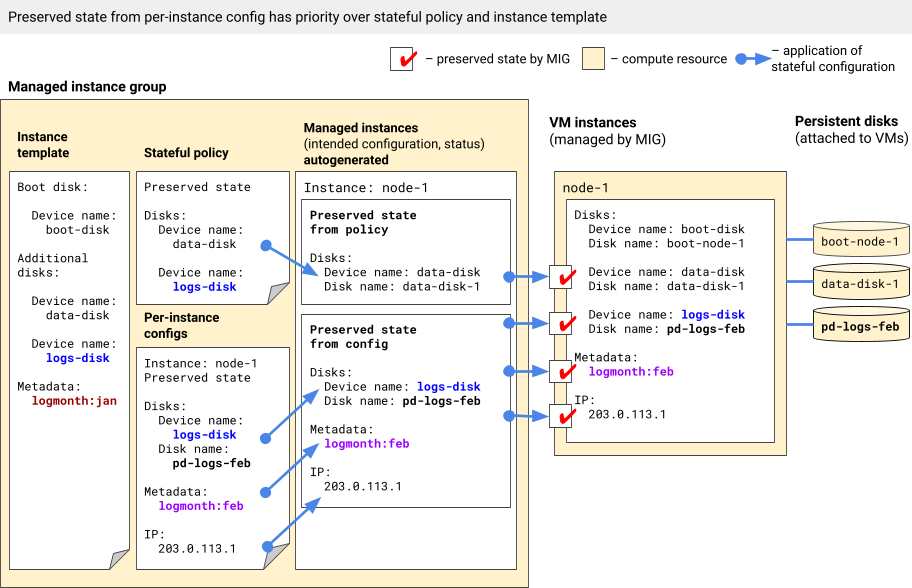
In the preceding figure:
- The instance template defines:
- Three disks for all instances in the MIG, with device names
boot-disk,data-disk,logs-disk. - Metadata common to all instances:
logmonth:jan.
- Three disks for all instances in the MIG, with device names
- The stateful policy declares that disks with device names
data-diskandlogs-diskare stateful; the boot disk remains stateless. - A per-instance configuration for the instance
node-1redefines:- Stateful configuration for a disk with device name
logs-disk: This instructs the MIG to attach the diskpd-logs-febtonode-1under thelogs-diskdevice name. - Metadata, defined in the instance template, with key value
logmonth:jan: This instructs the MIG to set valuelogmonth:febtonode-1.
- Stateful configuration for a disk with device name
- After you apply,
the configuration, the MIG automatically translates the
stateful policy and per-instance configuration into an instance-specific preserved
state, stored in the managed instance.
- The preserved state from policy instructs the MIG to preserve the
disk
data-disk-1for the VMnode-1. Note that the preserved state from policy does not include stateful configuration for the disk with device namelogs-diskbecause this configuration is overridden by the configuration forlogs-diskin the per-instance configuration. - The preserved state from configuration instructs the MIG to attach and
preserve persistent disk
logs-diskand to set and preserve metadatalogmonth:febfor VM instancenode-1. Note that the preserved state from configuration overrides the configuration forlogs-diskfrom the stateful policy and overrides metadatalogmonth:janfrom the instance template.
- The preserved state from policy instructs the MIG to preserve the
disk
How removing a resource from a stateful policy affects preserved state
If you remove a resource configuration from your stateful policy, the MIG
automatically removes the corresponding
preservedStateFromPolicy for
all managed instances. The compute resources remain attached to the instances,
but they are no longer stateful.
In the following example, removing a disk from the stateful policy leads to removal of that disk from preserved states from policy in all managed VMs. Those disks remain attached to their VMs, but they are no longer stateful and might be deleted and recreated on next VM recreation.
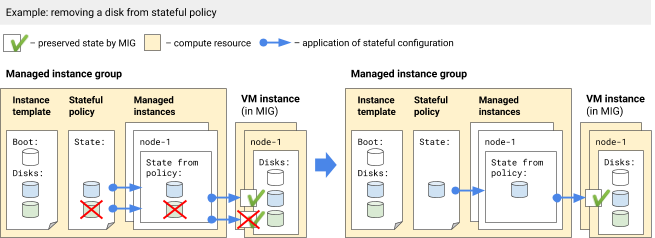
If the same item, for example, a stateful persistent disk, is present both in the stateful policy and a per-instance configuration, and you remove its stateful configuration from the stateful policy only, the MIG doesn't remove it from the per-instance configuration. For the corresponding VM, the configured resource remains stateful.
In the following example, removing the disk from the stateful policy does not lead to removal of the disk from the per instance configuration. The disk remains stateful because it is still a part of preserved state from configuration.
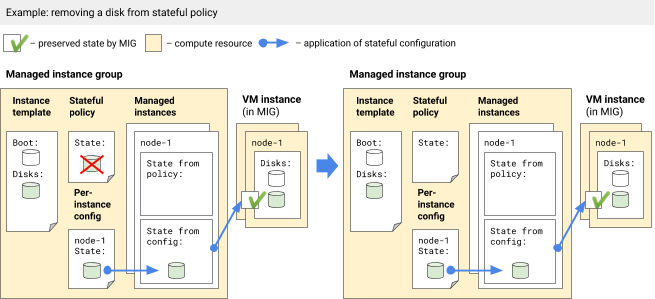
How removing items from per-instance configurations affects preserved state
If you remove the stateful configuration from a per-instance configuration, and apply
the change, the MIG automatically removes the stateful configuration from the
preserved state from configuration (preservedStateFromConfig) in the corresponding
managed instance. The compute resources that are no longer part of any preserved
state become stateless.
How removing stateful disks configuration from per-instance configurations affects preserved state
If you remove a stateful disk from a per-instance configuration and apply the change to the associated VM instance, the MIG does the following:
- The disk configuration is removed from the instance's preserved state from configuration.
- If a disk with the same device name is defined in the instance template but not configured in a stateful policy, then the disk stays attached to the given VM. However, the disk becomes stateless for the given VM and it might be recreated according to the instance template configuration on the next VM recreation, autohealing, or update event.
- If a disk with the same device name is not defined in the instance template, then it is automatically detached from the VM immediately upon application of the updated per-instance configuration to the associated VM, regardless of its auto-delete configuration.
- If a disk with the same device name is configured in a stateful policy, then its stateful policy configuration is translated into the preserved state from policy for the given managed instance, and the disk remains stateful.
In the following example, removing a blue and a green disk from node-1's
per-instance configuration leads to removal of both disks from the node-1 managed
instance's preserved state from configuration.
- The blue disk remains attached to the
node-1VM instance, but it is now stateless and can be recreated on the next VM recreation according to the instance template configuration. - The green disk is detached from the
node-1VM instance because the instance template does not define a disk with the same device name.
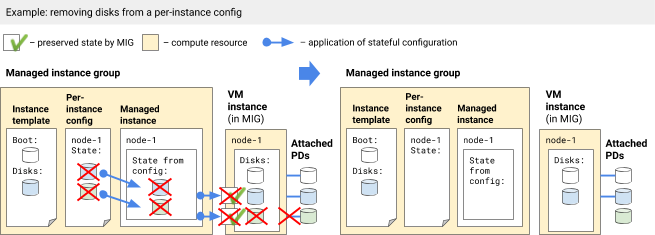
How removing stateful metadata from per-instance configurations affects preserved state
Removing stateful metadata from a per-instance configuration and applying the change causes the MIG to immediately remove that stateful metadata from the corresponding managed instance's preserved state:
- If you defined metadata with the same key in the instance template, the MIG immediately applies the value from the instance template to the instance.
- If the metadata with the same key is not defined in the instance template, the MIG immediately removes the key value from the instance.
In the following example, removing mode:dev and id:xyz273 metadata
from node-1's per-instance configuration leads to automatic removal of both key-value
pairs from the node-1 managed instance's preserved state from configuration.
mode:devis replaced by the instance template'smode:testin the VM.id:xyz273is removed from the VM immediately because the instance template does not have metadata with the same keyidto replace it with.
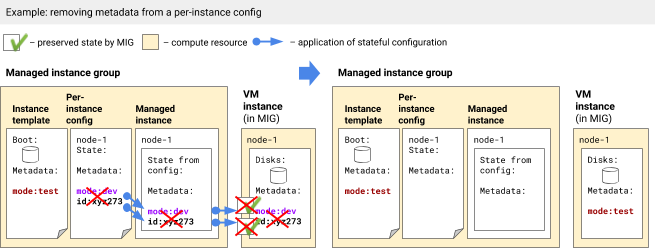
How removing stateful IP configuration from per-instance configurations affects preserved state
Removing the internal IP configuration from per-instance configuration makes the IP address for this VM stateless. No automated changes are performed on this VM, but the IP address can change after the VM is recreated, updated, or autohealed.
Fallback to stateful policy
If you remove the stateful configuration of a resource from a per-instance configuration, and you configured the same resource in the stateful policy, then the resource remains stateful according to the stateful policy.
The MIG automatically removes the item's stateful configuration from the
preservedStateFromConfig
and adds it to the
preservedStateFromPolicy
for the corresponding managed instance.
In the following example, removing a disk from node-1's per-instance configuration
does not lead to removal of the disk from the stateful policy. The disk
remains stateful according to the stateful policy:
- The MIG automatically removes the disk from the
preserveStateFromConfigfor thenode-1managed instance because the disk is no longer part of its per-instance configuration. - The MIG automatically adds the disk to the
preserveStateFromPolicyfor thenode-1managed instance because the stateful policy configuration is still in place and is no longer in conflict with thenode-1per-instance configuration.
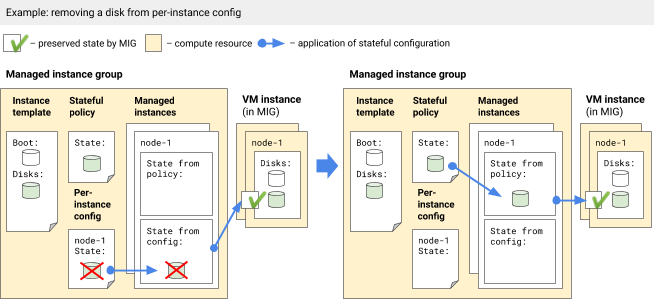
Feedback
We want to learn about your use cases, challenges, and feedback about stateful MIGs. Please share your feedback with our team at mig-discuss@google.com.
What's next
- Learn how different configurations and MIG actions affect preserved state.
- For information about how to support stateful workloads by preserving instance names, persistent disks, and metadata in managed instances, see Configuring stateful MIGs.
- Learn more about when to use stateful MIGs.
- Learn how to Migrate an existing workload to a stateful MIG.
- Learn more about MIGs.
- Work with managed instances.
